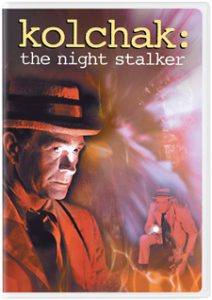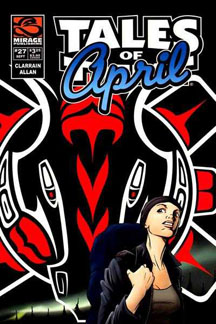In 2006, Mirage Volume 4 stopped its bimonthly publishing schedule and went to a trickle-out approach, but that same year, “Tales of the TMNT” Volume 2 continued as a monthly and put out more consistently compelling work than in its first two years.
April takes spotlight
A prime example is the Dean Clarrain/Chris Allan tale in Issue 27, the April story “White Horses.” (By the way, Clarrain is a pseudonym for “Tales” editor Steve Murphy, but since he uses his real name at other times, I’ll refer to him as Clarrain when he does so himself.
Obviously, he feels that Clarrain stories are different enough from Murphy stories that it’s worth using two names. Personally, I don’t know what differentiates the styles; I’ll leave that for someone who wants to dig even more obsessively into old “TMNT” comics.)

“Tales of the TMNT” Volume 2 Issues 19-30 (2006)
Writers: Stephen Murphy, Ross May, Jake Black, Peter Laird, Dan Berger, Chris Allan, Dave White, Bill Moulage
Pencils: Chris Allan, Ray-Anthony Height, Jim Lawson, Fernando Pinto, Dario Brizuela, Scott Cohn, Dan Berger, Mike Hawthorne, Diego Jourdan, Steve Rolston, Dave White
Inks: Chris Allan, Derek Fridolfs, Eric Talbot, Fernando Pinto, Andres Ponce, Sean Parsons, Mike Manley, Dan Berger, Mike Hawthorne, Ryan Brown, Diego Jourdan, Steve Rolston, Dave White, Dario Brizuela
Although I haven’t read much of Volume 4 beyond Issue 19 since I’m missing so many issues, I cheated and read Issue 22 in order to learn April’s mysterious origin story. This is perhaps a minority opinion, but I love the revelation that April was drawn by her dad using the magic crystal from the “Donatello” one-shot, “Kirby and the Warp Crystal.”
I think I’ve mistakenly referred to Volume 1, Issue 9 (September 1986), as “TMNT’s” first use of the supernatural in its storytelling, but the “Donatello” issue (May 1986) is actually the first.
April’s origin story reminds me a lot – in a good way – of Dawn’s in Season 5 of “Buffy.” In the cases of both Dawn and April (and the Turtles, now that I think about it), they were born in the weirdest way possible, but they’ve had to learn – as Splinter puts it in the movies – not to confuse the specter of their origin with their present worth.
A spiritual sequel to Volume 4, Issue 22, “White Horses” is a beautifully told tale where April travels to Alaska to learn that lesson. She goes from admitting to the Indian woman/white horse that she intended to die on the trip to begging the woman/horse to save her life.
She should feel good about her existence: Like all of us (ideally), April was borne of love. I also see April’s surprising origin story as Peter Laird’s love letter to art. In that sense, he is April’s father.

Also intriguing is the frontispiece (the introductory page where the main character says “Let me tell you a story …”). April is heroically posed on a rooftop’s edge, decked out in black garb with ninja weapons. In the movies and the Archie comics, April gains fighting skills, but this marks the first example of Mirage taking her in that direction.
Splinter to the fore
It’s remarkable that 22 years after the first issue, we’re still learning key things about “TMNT’s” main characters. Another good yarn, which also taps into the supernatural, is Ross May’s Issue 19 (“A Ghost Story”). The Turtles travel to Splinter’s home village and learn that his master Hamato Yoshi’s house is being haunted by Yoshi, Tang Shen and Oroku Nagi.
And then Issue 22 (“Change of Power,” Ross May and Laird) welcomes back Hattori, the grandson of the man with whom Splinter swaps bodies on the astral plane back in Volume 1 Issue 9. Hattori then goes on to join the Turtles in their Feudal Japan adventure in Issues 46-47 that loosely (but obviously) inspired “TMNT III.”
Here, Hattori – having recruited the Turtles’ assistance – attacks his family’s crime syndicate with the goal of ending it and killing the leaders. In a twist, in turns out the Foot Clan has taken it over, and the leader of this particular branch of the Clan seeks vengeance against the “family” of Hamato Yoshi (Splinter and the Turtles). But we don’t find out why.
A cliffhanger is all well and good, except that we never found out this woman’s identity throughout the whole run of 70 “Tales” issues! (Check out Mark Pellegrini’s “Tales” Volume 2 reviews over at TMNT Entity for more on the subject of truncated storylines, something that frustrates him – along with all fans of Mirage TMNT continuity – to no end.)
Luckily, this is one of those cases where the unofficial but brilliant Volume 3 Issues 24-25 help us out. Drawing from May’s story notes, we learn that the female ninja is Tang Amaya, sister of Tang Shen, who misunderstood the events of that fateful night and blamed Yoshi rather than Saki.
Mikey the novelist
Issue 30 (“Circle of Darkness,” Bill Moulage) is wonderful in the way it continues a through-line that had been largely forgotten: In Volume 1 Issue 17, Mikey takes up novel writing, and he becomes quite successful at it in Volume 3. While Laird declared Volume 3 non-canon, it nonetheless doesn’t have many apocryphal elements, especially with the addition of the fan-produced Issues 24-25.
Not only does Moulage have Mikey writing another novel, but he also tells the story via Mike’s inner thoughts, similar to Volume 1 Issue 17 (indeed, the actual writing credit on this issue is “Michelangelo, as told to Bill Moulage”). Evocative real-world NYC settings, such as the Flatiron Building, tie it all together.
And also for continuity buffs, this story was referenced in a throwaway line in Volume 4, Issue 18 (published prior to this), making this one of the very few (the only?) “stories yet to be told” that actually is told.
As a bonus, Issue 30 includes the Will Tupper vignette “Mother of All Anger,” which posits the intriguing idea that Raph’s frustrations come in part from never getting to know his mother (and even if he did meet her, she’d just be a turtle, of course, rather than a thinking being like himself).
Sci-fi dominates
Science fiction dominates most of this batch, and in a good way. Dan Berger wraps up his Leatherhead trilogy (Volume 1, Issue 45; “Tales” Volume 2, Issue 8, and now Issue 23) with “Attack of the Replicants.” While it’s clear by this point that the Utroms’ motives for visiting Earth are good, we’re also starting to meet a lot of splinter groups within that race.
Here, it’s a sect called The Illuminated that aims to exterminate all races that are prone to violence in order to bring about a more peaceful universe. Like everyone in history who has had similar thoughts, they don’t recognize the irony or hypocrisy.
Their method is to create an army of cloned Leatherheads. In a neat twist, Emissary Ribky – the Utrom who was driving the TCRI truck that spilled the mutagen on that fateful day – has always felt responsible for the well-being of the Turtles and Leatherhead, so he sacrifices himself to save them and defeat The Illuminated.
Murphy’s Issue 24 (“Rock of Ages”) delivers an even bigger sci-fi idea in a denouement where we learn the robots the Turtles are fighting are actually shells for humans – humans that existed and then were largely wiped out by climate change before contemporary humans came about.
It got me thinking about all the extraterrestrial humans we’ve met in “TMNT” stories. Could this be the long-awaited explanation of their origin? We get no definitive answer here, but it’s compelling evidence, for sure.
Murphy’s Issue 28 (“Shanghaied”) strikes a decidedly lighter tone even with its high stakes: Raphael and Cha Ocho escape a building-turned-spaceship that is departing Earth with drugged humanoids. But the cool thing here is that the Turtle and Foot Soldier are now drinking buddies!
Steve Rolston’s long string of panels of the two of them just sitting at the bar barely moving and exchanging small talk is highly amusing. Raph immediately figures out which brother Cha is referring to when he says “the one who did this to my face.” “Ah, that would be Leo,” Raph says. “I guess he must’ve been making one of his ‘points.’ “
Issue 29 (“Soul Survivor,” Dave White) is an important origin story, although not one that held my attention. Donatello and an Utrom scientist travel to a planet between Triceraton and Styracodon (the species of Mike’s Volume 4 girlfriend) space and discover that (in a case of “no duh”) the two dinosaurian species shared a common ancestor.
Don fighting a giant Triceraton calls to mind Laird’s jaunt into Triceraton space back in the Original 16 Eastman & Laird issues; good sci-fi adventure, for what it’s worth, but not really my cup of tea.
Tackling current events
As for the truly down-to-Earth tales, Murphy’s Issue 26 (“The Value of Gold”) is among the most sharply written to this point in the series, as the crimefighting Turtles run into a conundrum when the bad guy – who hires people to earn virtual gold in online games, then sells that “gold” on eBay for real dollars – isn’t doing anything illegal, and he’s not necessarily even doing anything immoral, as the “victims” of this “criminal” don’t want to be saved. The workers even ask Don, Raph and Casey to depart:
“The hours can be long, the work hard on the eyes, neck and back. They pay, indeed, can seem not quite fair. But we have little choice. We are all here illegally. We all have families to feed, lives that depend on us.”
As such, what starts out as a “greedy corporatists versus oppressed workers” story ends up being a strong argument for open immigration based on work visas.
They’re not all golden
I suppose it’s inevitable that any batch of Turtles comics will have a couple goofy ones in there. Issue 25 (“Kung-Fu Theatre”) by Murphy and Laird finds the Turtles and Foot soldiers falling into a theater that just happens to have an audience of rival martial arts studios, and a big, goofy fight breaks out. Still, with Lawson’s pencils reunited with Ryan Brown’s inks and tones a la “Tales” Volume 1, it’s a fun throwback.
But Issue 21 (“A [Bull] Wrinkle in Time”)? Not so much. This tale is a crossover with Brown’s kiddie-oriented “Wild West C.O.W.-Boys of Moo Mesa” (cowboys who are anthropomorphic cows). While the C.O.W.-Boys are natural offshoots of the Turtles considering that Brown spent the late 1980s dreaming up mutant “TMNT” characters for Mirage and Playmates toys, let’s just say the connection between the franchises could’ve been left at that.
The mutli-story Issue 20 (“The Trophy” and “The Cure” by Steve Murphy and “The Rippling” by Jake Black, Murphy and Peter Laird) is less goofy, but still not good. “The Trophy” is a ridiculous morality play where Splinter attacks and accuses a hunter of killing a deer only for a trophy, not for meat, even though he has no evidence of that. For what it’s worth, the Michaelangelo entry in “Challenges” is a better anti-trophy-hunting yarn.
“The Cure” is noteworthy in that it ties in with the Volume 2 arc where Leo inexplicably slaughters a gigantic sea turtle; the fish people from back in Volume 1 Issue 28 also are in this arc for some reason. I guess this provides closure, although I whiffed on understanding the point of the whole thing.
“The Rippling” is the best of this issue, such as it is. It’s a character study where each of the Turtles sees what he wants to see thanks to a magic orb.

